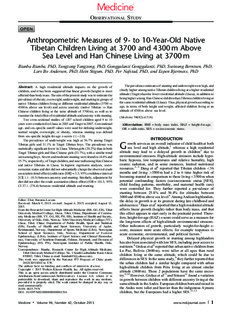| dc.contributor.author | Bianba, Bianba | |
| dc.contributor.author | Yangzong, Yangzong | |
| dc.contributor.author | Gonggalanzi, Gonggalanzi | |
| dc.contributor.author | Berntsen, Sveinung | |
| dc.contributor.author | Andersen, Lars Bo | |
| dc.contributor.author | Stigum, Hein | |
| dc.contributor.author | Nafstad, Per | |
| dc.contributor.author | Bjertness, Espen | |
| dc.date.accessioned | 2016-05-13T09:13:19Z | |
| dc.date.available | 2016-05-13T09:13:19Z | |
| dc.date.issued | 2015-10 | |
| dc.identifier.citation | Medicine (Baltimore, Md.). 2015, 94, e1516. doi:10.1097/MD.0000000000001516 | nb_NO |
| dc.identifier.uri | http://hdl.handle.net/11250/2389392 | |
| dc.description | This is an open access article distributed under the Creative Commons Attribution-NonCommercial-NoDerivatives License 4.0, where it is permissible to download, share and reproduce the work in any medium, provided it is properly cited. The work cannot be changed in any way or used commercially. http://creativecommons.org/licenses/by-nc-nd/4.0 | nb_NO |
| dc.description.abstract | A high residential altitude impacts on the growth of children, and it has been suggested that linear growth (height) is more affected than body mass. The aim of the present study was to estimate the prevalence of obesity, overweight, underweight, and stunting in groups of native Tibetan children living at different residential altitudes (3700 vs 4300 m above sea level) and across ancestry (native Tibetan vs Han Chinese children living at the same altitude of 3700 m), as well as to examine the total effect of residential altitude and ancestry with stunting.
Two cross-sectional studies of 1207 school children aged 9 to 10 years were conducted in Lhasa in 2005 and Tingri in 2007. Conventional age- and sex-specific cutoff values were used for defining underweight, normal weight, overweight, or obesity, whereas stunting was defined from sex-specific height-for-age z-scores (≤−2.0).
The prevalence of underweight was high at 36.7% among Tingri Tibetan girls and 31.1% in Tingri Tibetan boys. The prevalence was statistically significant lower in Lhasa Tibetan girls (20.2%) than in both Tingri Tibetan girls and Han Chinese girls (33.7%), with a similar trend seen among boys. Severe and moderate stunting were found in 14.6% and 35.7%, respectively, of Tingri children, and near null among Han Chinese and native Tibetans in Lhasa. In logistic regression analyses, socioeconomic status and diet did not substantially change the observed crude association (total effect) (odds ratio [OR] = 3.3; 95% confidence interval [CI] 1.1–10.3) between ancestry and stunting. Similarly, adjustment for diet did not alter the crude association (direct effect) (OR = 101.3; 95% CI 37.1–276.4) between residential altitude and stunting.
The prevalence estimates of stunting and underweight were high, and clearly higher among native Tibetan children living at a higher residential altitude (Tingri) than the lower residential altitude (Lhasa), in addition to being higher among Han Chinese children than Tibetan children living at the same residential altitude (Lhasa). Thus, physical growth according to age, in terms of both height and weight, affected children living at an altitude of 4300 m above sea level. | nb_NO |
| dc.language.iso | eng | nb_NO |
| dc.publisher | Wolters Kluwer | nb_NO |
| dc.title | Anthropometric measures of 9-to 10-year-old native Tibetan children living at 3700 and 4300m above sea level and Han Chinese living at 3700m. | nb_NO |
| dc.type | Journal article | nb_NO |
| dc.type | Peer reviewed | nb_NO |
| dc.subject.nsi | VDP::Medical disciplines: 700 | nb_NO |
| dc.source.journal | Medicine (Baltimore, Md.) | nb_NO |
| dc.description.localcode | Seksjon for idrettsmedisinske fag / Department of Sport Medicine | nb_NO |
